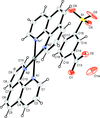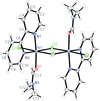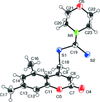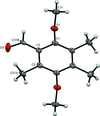issue contents
February 2016 issue

Cover illustration: The crystal structure of the hydrated double salt Cs+·[N(CH3)4]+·[B12H12]2-·H2O is stabilized by a three-dimensional network of O-H H-B and C-H
H-B and C-H H-B dihydrogen bonds. See: Tiritiris & Schleid [IUCrData (2016). 1, x160291].
H-B dihydrogen bonds. See: Tiritiris & Schleid [IUCrData (2016). 1, x160291].
metal-organic compounds
Download citation


Download citation


Open  access
access
 access
accessIn the crystal of the complex comprising a [Pt(1,10-phen)2]2+ complex cation (1,10-phen = 1,10-phenanthroline), two 3-sulfobenzoate anions and two lattice water molecules, the anions and water molecules form hydrogen-bonded centrosymmetric dimers. In addition, π–π interactions are observed between 1,10-phenanthroline ligands and 3-sulfobenzoate anions.
CCDC reference: 1451710
Download citation


Download citation


Open  access
access
 access
accessIn the structure of N-ferrocenymethyl-N-phenylacetamide, the asymmetric unit comprises two unique molecules with the two cyclopentadienyl rings of each ferrocene residue nearly eclipsed and parallel to one another. In the crystal, C—H⋯O hydrogen bonds stack molecules along a.
CCDC reference: 1451430
Download citation


Download citation


Open  access
access
 access
accessThe title compound is a one-dimensional helical coordination polymer. The C—Ag—N bond angle is 168.3 (1)°.
CCDC reference: 1452331
Download citation


Download citation


Open  access
access
 access
accessThe crystal structure of [(bipy)(μ-Cl)NiCl(DMF)]2 is reported. The compound exists as a dimer with two octahedral nickel atoms.
CCDC reference: 1453181
Download citation


Download citation


Open  access
access
 access
accessIn the hydrated title compound, the crystal structure is stabilized by B—H⋯H—O and B—H⋯H—C dihydrogen bonds.
CCDC reference: 1454125
Download citation


Download citation


Open  access
access
 access
accessThe asymmetric unit of the solvated title salt comprises two cations, one half [Bi4Cl16]4− ion and one acetonitrile molecule. The C—N bond lengths in both guanidinium ions indicate double-bond character, pointing towards charge delocalization within the NCN planes. The crystal structure is stabilized by a three-dimensional network of C—H⋯Cl hydrogen bonds.
CCDC reference: 1455405
organic compounds
Download citation


Download citation


Open  access
access
 access
accessThe bond lengths in the cation of the title salt, C12H24N42+.2 C24H20B−, indicate delocalization of the positive charges over the dimethylamino groups.
CCDC reference: 1450255
Download citation


Download citation


Open  access
access
 access
accessThe title compound, C11H10O3, contains two crystallographically independent molecules with similar conformations (r.m.s. overlay fit = 0.105 Å); both form carboxylic acid inversion dimers linked by pairs of O—H⋯O hydrogen bonds in the crystal.
CCDC reference: 1401315
Download citation


Download citation


Open  access
access
 access
accessThe crystal structure of 6-fluoro-1H-indole-2,3-dione is reported. In the crystal N—H⋯O, C—H⋯O and C—H⋯F interactions are present.
CCDC reference: 1450254
Download citation


Download citation


Open  access
access
 access
accessThe 15 non-H atoms in the title compound are coplanar with the methyl group sitting prime to the plane. Supramolecular undulating ribbons sustained by C—H⋯O interactions are found in the crystal structure.
CCDC reference: 1448516
Download citation


Download citation


Open  access
access
 access
accessThe title molecule, C18H18N2O5, is close to planar (r.m.s. deviation = 0.173 Å). Weak C—H⋯O interactions and aromatic π–π stacking occur in the crystal.
CCDC reference: 1450256
Download citation


Download citation


Open  access
access
 access
accessIn the crystal of the title compound, C17H19NO3S2, inversion dimers linked by pairs of weak C—H⋯O hydrogen bonds generate  (16) loops.
(16) loops.
CCDC reference: 1450290
Download citation


Download citation


Open  access
access
 access
accessIn the title compound, C18H21NO2S2, the dihedral angle between the coumarin unit and the piperidine ring is 60.54 (8)°.
CCDC reference: 1450258
Download citation


Download citation


Open  access
access
 access
accessThe crystal structure of 5-bromo-1H-indole-2,3-dione is reported. In the crystal, molecules are linked by N—H⋯O and C—H⋯O interactions.
CCDC reference: 1450609
Download citation


Download citation


Open  access
access
 access
accessThe fused cyclic system of the title compound, commonly known as limonin, consists of a cyclohexane, a cyclohexanone, a furan, an epoxide and two lactone rings.
CCDC reference: 1450293
Download citation


Download citation


Open  access
access
 access
accessThe crystal structure of C13H19Cl2N2+·Cl− determined at 100 K resolves the disorder of the chloropropyl group that was observed in the room-temperature structure.
CCDC reference: 1450257
Download citation


Download citation


Open  access
access
 access
accessIn the solvated title compound, the C—N bonds in the CN3 unit of the dication show partial double-bond character and one positive charge is delocalized. The second positive charge is localized in the trimethylammonium group. The crystal structure is stabilized by N—H⋯O and C–H⋯O hydrogen bonds. C—H⋯π interactions are present between the guanidinium H atoms and the phenyl C atoms of the tetraphenylborate ions.
CCDC reference: 1448754
Download citation


Download citation


Open  access
access
 access
accessThe title compound, which is an analogue of ligands used in olefin polymerization catalysts, crystallizes with two molecules in the asymmetric unit, both of which feature intramolecular O—H⋯N hydrogen bonds.
CCDC reference: 1451497
Download citation


Download citation


Open  access
access
 access
accessIn the 6H-dipyrido[1,2-a:2′,1′-d][1,3,5]triazin-5-ium cation, the central 1,3,5-triazinium ring has a flat boat conformation and the outer heterocyclic rings are nearly planar. In the crystal, classical O—H⋯Br hydrogen bonds and weak C—H⋯Br and C—H⋯O hydrogen bonds link the cations, bromide anions and lattice water molecules into a three-dimensional supramolecular network.
CCDC reference: 1450784
Download citation


Download citation


Open  access
access
 access
accessThe title compound crystallized with two independent molecules (A and B) in the asymmetric unit. In the crystal, the molecules are linked to one another via N—H⋯O hydrogen bonds forming –A–B–A–B– chains along [100].
CCDC reference: 1451096
Download citation


Download citation


Open  access
access
 access
accessIn the title dithiocarbazate derivative, the trimethoxyphenyl group and the dithiocarbazate fragment lie almost in the same plane; the mean plane of the dithiocarbazate unit being inclined to the trimethoxyphenyl ring by 13.34 (6)°.
CCDC reference: 1434503
Download citation


Download citation


Open  access
access
 access
accessThe crystal packing of the compound does not feature any specific strong or weak intermolecular interactions.
CCDC reference: 1451830
Download citation


Download citation


Open  access
access
 access
accessIn the crystal structure of 4-iodo-1H-indole-2,3-dione, both N—H⋯O hydrogen bonds and I⋯O and π–π interactions are observed.
CCDC reference: 1451748
Download citation


Download citation


Open  access
access
 access
accessIn the solvated title compound, the C—N bonds in the CN3 units of both dications show partial double-bond character and one positive charge is delocalized. The second positive charge is localized in the trimethylammonium groups. The crystal structure is stabilized by C—H⋯O and C—H⋯π interactions.
CCDC reference: 1452058
Download citation


Download citation


Open  access
access
 access
accessThe title compound displays a `propeller-like' structure, with the mean planes of the two alloxan units almost normal with respect to the central aromatic ring and inclined to one another by 40.86 (7)°. This compound can be used as a model for possible binding to a solid phase for separation techniques of certain ion-pairs from aqueous solutions.
CCDC reference: 1451787
Download citation


Download citation


Open  access
access
 access
accessThe nearly planar title molecules are linked by a pairs of N—H⋯O interactions into an inverson dimer. The dimers are connectec by weak H⋯Cl interactions into a two-dimensional hydrogen-bonded polymer and stacked along the b axis, connected by weak π–π interactions. An in silico evaluation of the title compound with an topoisomerase enzyme was performed and several intermolecular interactions can be assigned.
CCDC reference: 1453122
Download citation


Download citation


Open  access
access
 access
accessThe crystal structure of 4-bromo-1H-indole-2,3-dione is reported. In the crystal, N—H⋯O, Br⋯O and π–π interactions are present.
CCDC reference: 1445034
Download citation


Download citation


Open  access
access
 access
accessThe crystal structure of 7-bromo-1H-indole-2,3-dione is reported. In the crystal, N—H⋯O, Br⋯O and π–π interactions are present.
CCDC reference: 1453500
Download citation


Download citation


Open  access
access
 access
accessThe molecule is a double zwitterion with two of the carboxylic acid H atoms transferred to the two N atoms. Intermolecular N—H⋯O and O—H⋯O hydrogen bond involving the ammonium groups, the carboxylate groups and the water molecules are observed.
CCDC reference: 1452936
Download citation


Download citation


Open  access
access
 access
accessThe bicyclic core of the title compound is slightly folded [1.9 (1)°], while pairwise intermolecular N—H⋯O hydrogen bonding forms dimers across centers of symmetry.
CCDC reference: 1453514
Download citation


Download citation


Open  access
access
 access
accessInteraction of the arylamido germylene [Ph2Si(DippN)2Ge:] with elemental sulfur afforded a new germanethione dimer and its structure is reported here.
CCDC reference: 1454736
Download citation


Download citation


Open  access
access
 access
accessThe molecular and crystal structure of the centrosymmetric 2,5-dimethoxy-3,4,6-trimethylbenzaldehyde is reported. The methyl and aldehyde substituents are disordered over four carbon atoms of the benzene ring.
CCDC reference: 1454961
Download citation


Download citation


Open  access
access
 access
accessThe cyanide group is anti to the iodide substituent of the adjacent benzene ring. Supramolecular C(8) chains, mediated by C—H⋯N interactions, are found in the molecular packing.
CCDC reference: 1455354


 journal menu
journal menu












































![[publCIF]](/logos/authorchecklist11.gif)





